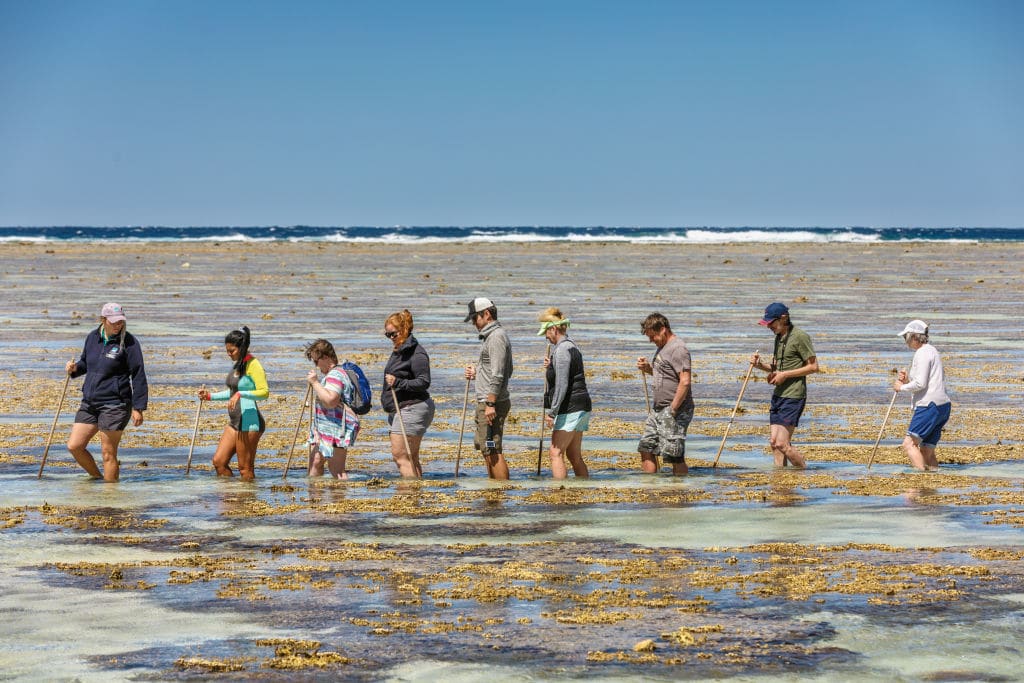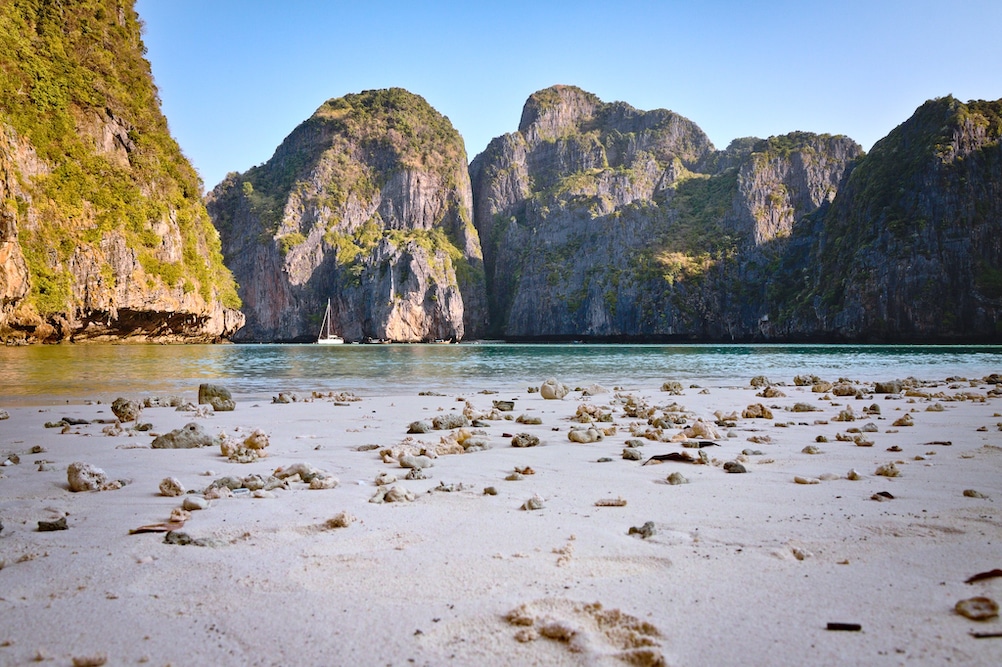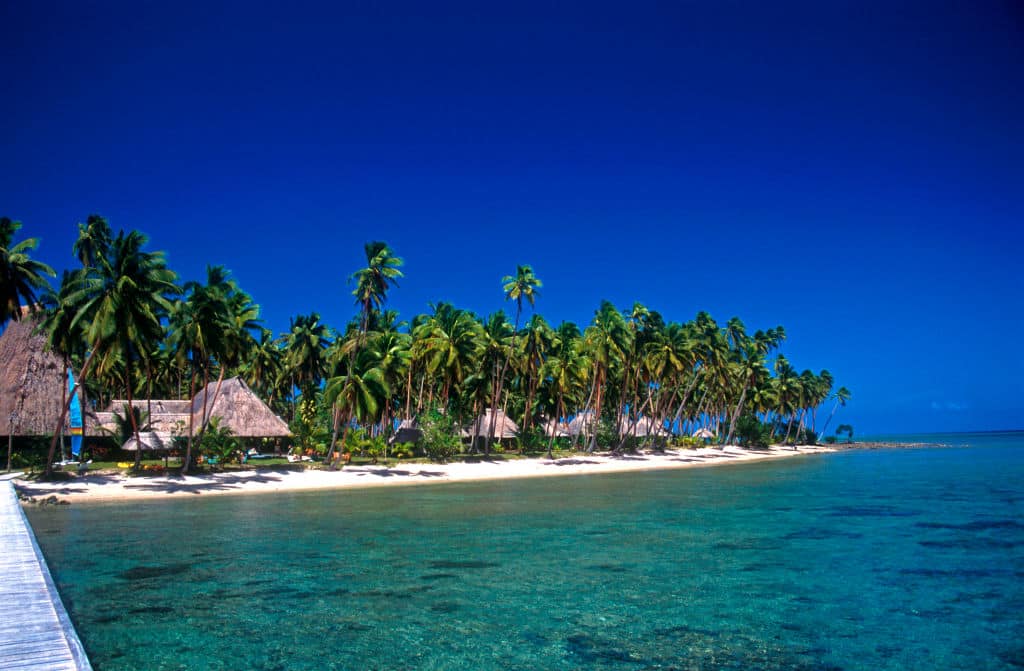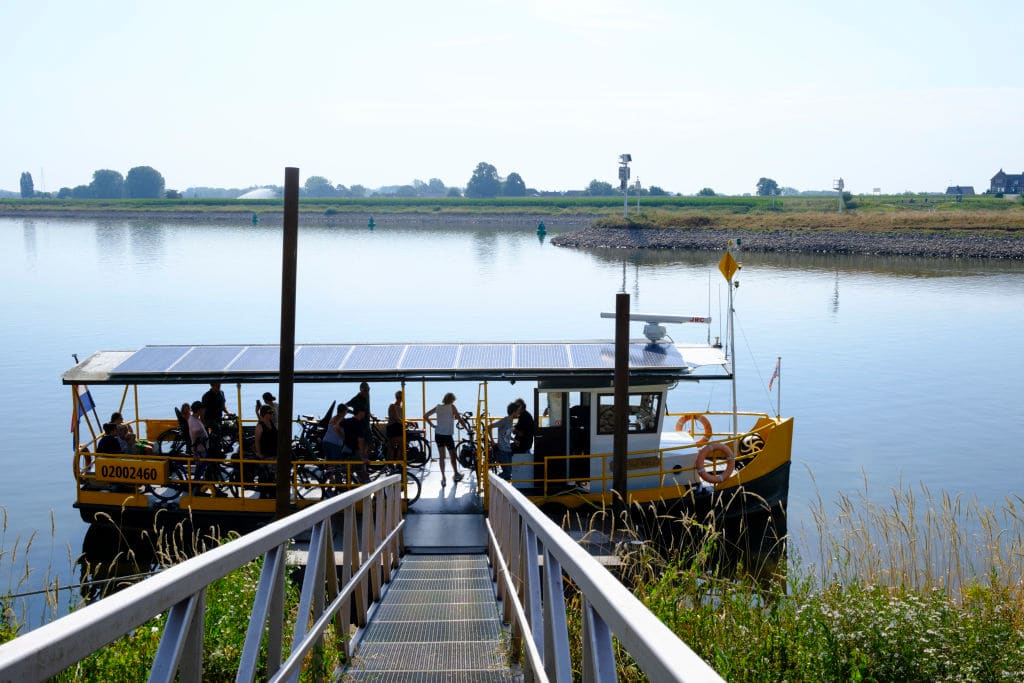
Quick Key Facts
- The aviation industry is responsible for about 2.4% of global carbon emissions.
- Commercial aviation emissions could triple by 2050.
- As much as 80% of corals were destroyed from overtourism at Maya Beach in Thailand.
- Litter in the Mediterranean increases 40% during peak travel season.
- In the U.S., we could sustainably collect about 1 billion dry tons of biomass to produce 50 to 60 billion gallons of biofuels per year.
- The United Nations Environment Programme reported that the number of travelers in 2023 so far is already double the amount of travelers in the same time period last year.
- Eight in 10 travelers visit coastal regions, and this can contribute to more ocean pollution.
- Overtourism in Hawaii has left locals with water shortages and fines for certain types of water usage, while resorts do not face these punishments.
- Over 76% of people in a recent Booking.com survey want to travel more sustainably over the next year.
- Travelers can lessen their impact in a number of ways, from going zero-waste to eating plant-based to avoiding animal entertainment while traveling.
What Is Sustainable Travel?
Sustainable travel can mean many things and take several forms, but in general it refers to tourism that leaves the smallest, if any, impact on ecosystems around the world while also respecting local customs and cultures. Sustainable tourism should take current and future impacts of all travel-related actions into account, such as how your visit could impact native wildlife or support the local economy.
There are many ways to embrace sustainable travel, from skipping plane rides in favor of taking a train or driving an EV to booking eco-friendly accommodations over big chain hotels. While the bulk of the responsibility for sustainable travel should still fall on the biggest polluters to make changes, like developing biofuels or building low-impact accommodations that won’t interfere with ecosystems, individuals can still make decisions to lessen their impact and signal to businesses that there is demand for more sustainable choices in travel and tourism.
Types of Sustainable Travel
Sustainably minded travelers can find many ways to travel with the environment in mind. Sustainable travel can be broken into several related categories of travel, which tourists can consider based on their destinations and preferences.
Slow Travel
Some people love a jam-packed itinerary, where they can visit all the major sites in a city and check off all the best restaurants. But this fast-paced travel often can lead to a lot more jet-setting and use of convenience items, including single-use plastic items, in order to get from place to place as quickly as possible.
Instead, slow travel encourages a more thoughtful, drawn-out approach that emphasizes immersive experiences and giving back to local communities. Some examples may include taking the train from one city to another instead of flying, taking a cooking class instead of going to the most popular restaurants, or going to one special exhibit at a museum and engaging with visiting artists rather than trying to hit multiple museums in one day.
Eco-Tourism
If hiking and camping sound like dream vacation activities, eco-tourism will be right up your alley. This form of sustainable travel is all about embracing nature, minimizing impact on landscapes and supporting local cultures tied to nature. For instance, if you’re hoping to do a guided hike, you’d sign up for one with a local guide instead of turning to a major tourism company. The goal of eco-tourism is to encourage an appreciation for nature.

Agritourism
Agritourism, or agrotourism, involves visiting a working farm. You may have a full farmstay, where you have lodgings somewhere on the farm, or you may just visit the farm and participate in on-site activities. To be sustainable, though, the agritourism should put animal welfare and environmental stewardship first. Some activities you could expect at an agritourism destination include picking fruits from an orchard, picking pumpkins at a pumpkin patch, attending cooking or baking classes that use fresh ingredients from the farm, or helping to feed and care for animals.
Regenerative Tourism
The idea behind regenerative tourism is for those participating in the tourism industry, from travelers to businesses to governments, to give more to local communities and ecosystems than they are taking. For example, someone could participate in regenerative tourism by picking up trash off the beach they are visiting, participating in a native tree planting event, or participating in other volunteer activities during your vacation.
Problems With Tourism
So why do we need to focus on traveling sustainably in the first place? Although exploring the world can be good for the traveler, it isn’t always so great for Earth or the destination communities. Overtourism can damage native plants in an area or stress local wildlife, and aviation alone is a major contributor to global emissions.
Transit Emissions
As of 2018, aviation emissions make up 2.4% of total global carbon emissions, as reported by the Environmental and Energy Study Institute. The commercial aviation industry’s emissions could triple by 2050. In addition to emitting carbon dioxide, planes and jets also emit water vapor, which can influence warming even more than carbon dioxide. Aircraft also contribute to air pollution by emitting nitrous gases, including nitrogen oxide, sulfates, and soot.
Overtourism
When too many people crowd into an area, they can have a major impact on local ecosystems and communities. Overtourism can cause housing prices to skyrocket, and a growing issue for many communities is the rise of people buying property in tourist destinations to use as temporary rentals, leaving less housing for locals.
There are many examples of overtourism’s negative impact on nature. Back in 2018, Thailand’s Maya Bay, which became extremely popular because of the film The Beach, had to close for over four years. The area had been decimated by crowds. Litter, boat pollution and sunscreen contributed to the destruction of up to 80% of local coral reefs.

Another example close to home, the Southern California poppy superblooms often attract massive crowds. But as people idle in their cars waiting in line to find parking and trample poppies as they try to get photos, they can cause lasting damage to the area. When people step or lie on the poppies, or even step off of marked trails, they can compact the soil and prevent the poppies from regrowing in the future, as explained by the Antelope Valley California Poppy Reserve.
Plastic Pollution
Think about it: the mini shampoos, body washes and lotions at hotels; the plastic water bottles at the airport; the food packaging and containers at convenience stores and restaurants. The world has a major problem with plastic pollution, and the travel industry is no exception.
The number of people traveling in 2023 is already double the amount of travelers in the same timeframe in 2022, according to the United Nations Environment Programme. Most tourists, about 80%, visit beaches and coastal regions, and as much as 8 million metric tons enter ocean ecosystems annually. This amount is expected to increase in the coming decades.
Strain on Local Resources
Tourism, especially when places become overcrowded with travelers, can put a major strain on resources, particularly water. Overtourism in Hawaii has left the locals to face water shortages, even facing fines for using water for certain activities, while resorts did not have to pay fines for water usage.
With the worsening climate crisis, more and more regions are facing extreme drought conditions and experiencing water shortages and restrictions, which are only made worse when more people are coming into the area as tourists, using the water without restrictions or fines. Tourists may even consume more water when traveling, especially when traveling somewhere hotter than they are used to. According to the Global Development Research Center (GDRC), tourists to the Mediterranean may consume up to 440 liters of water per day, double the average amount of water used in a city in Spain.
Examples of Sustainable Travel
When you’re ready to start traveling more sustainably, you may be wondering what to look for before booking accommodations, transit tickets and even restaurants. While there’s still a long way to go in terms of reducing travel-related emissions, there are some great examples of places focused on sustainable travel, plus ongoing developments to make parts of the industry — particularly aviation — less damaging.
Aviation Fuels
Many commercial airlines have made commitments to reach net-zero carbon emissions later this century, and one way to do this is by developing biofuels. Biofuels may be made from synthetic materials, agricultural waste or crops. According to the U.S. Department of Energy, the U.S. could collect about 1 billion dry tons of biomass, like corn grain, algae, oil seeds, and wood mill waste, per year that could produce 50 to 60 billion gallons of biofuels.
Some airlines, including United, Jet Blue, Emirates, Virgin Atlantic, Virgin Australia, British Airways and more, are already using fuel blends containing biofuels for select flights.
There needs to be more development here, since producing biofuels may still require land for growing crops for fuel, and biofuels will need to be combined with carbon capturing technology and carbon offsets to really make an impact.
Accommodations
More booking platforms are making it easier to find sustainable accommodations, especially since 76% of respondents in a recent Booking.com survey said they wanted to travel more sustainably this year. Booking.com itself and TripAdvisor offer badges and search settings to help customers find sustainably minded hotels. Google also has features to highlight eco-certified hotels.
One top example of an eco-minded lodging is the Jean-Michel Cousteau Resort in Fiji, which has been embracing sustainability since the 1990s. In addition to lessening its impact, the resort caters to regenerative tourism with its mangrove reforestation program.

Another resort, Calilo in Greece, is also adopting a regenerative attitude toward travel accommodations. The owners have bought beachfront land on the Ios island to keep it undeveloped. It is also leading a conservation project, which has planted 68,842 olive trees so far to reforest an area destroyed by multiple wildfires and deforestation.
There are plenty more lodgings, from tiny bed and breakfasts to luxury resorts, that are working to change how we travel. Of course, if you’re not sure where to start in booking an eco-hotel, you can also explore one of the world’s greenest cities, where you’re sure to find sustainable accommodations, restaurants, transit options and more.
Food and Beverages
From visiting a vineyard for wine tastings to sitting down at a restaurant for breakfast, lunch and dinner, there are many ways you can consider the environment even when dining during your trip.
When considering wineries, you can look for places with any number of sustainability-focused certifications, including organic, Sustainability in Practice (SIP), Demeter for biodynamic wine, Low Input Viticulture & Enology (LIVE), or Lodi Rules.
For beer-lovers looking for sustainable brews, look for certifications like Craft Responsibility In Sustainable Practices (C.R.I.S.P.), B-Corp or organic, and stick to local breweries when you can for an even smaller impact.
As for restaurants, look for places offering plant-based meals, locally grown and organic produce and proteins or even farm-to-table establishments. Some top examples of the most sustainable restaurants in the world include two fine dining spots, Aponiente and Azurmendi, in Spain, the zero-waste Silo London in the UK or Uncommon Ground in Chicago, which hosts the first organic certified rooftop farm in the U.S. at one of its locations. However, these are just a few of countless restaurants globally that are focused on sustainable eats. Part of the fun of sustainable travel is finding those hidden gems on your own.
Ways to Practice Sustainable Tourism
You’re not limited to hanging out in your backyard and forgoing all travel. When you want to explore the world, there are many things you can do to limit your impact.
Consider Transportation
Until sustainable biofuels are available for commercial flights, flying remains a top contributor to global emissions. Aviation makes up over 2% of all energy-related emissions, according to the International Energy Agency (IEA). If you can travel somewhere by another method, like driving (especially if you drive an EV) or even taking a train, you can lower your travel-related emissions.
When you get to your destination, keep in mind how you’re getting from your hotel to restaurants, museums, parks and other sites. Can you walk or rent a bike instead of driving? Can you make use of public transit? By doing so, you can lessen the amount of emissions from your trip.

Eat Plant-Based
Any time you can reduce animal products in your diet is a win for the environment, even if you’re on the road. Although going vegetarian or vegan lowers individual emissions less than reducing aviation travel, you can find ways to do both to help reduce emissions. If you don’t already follow a vegan or vegetarian lifestyle at home, consider eating more plant-based meals during your travels.
Find Sustainable Lodgings
While your travel rewards points may make it appealing to stay with a major hotel chain, opt for locally owned accommodations instead to better support the local economy and community. No matter where you decide to stay, do your research. Support lodgings with green credentials and sustainable efforts beyond simply only providing toiletries on request or only cleaning the room by request. Some certifications to look out for include EarthCheck, Audubon Green Lodging Program, Green Globe Certification, Green Tourism Active Global and Green Key Global.
Go Zero-Waste
Reducing your landfill waste is a great way to lessen your impact on ecosystems around the world. Not only does following a zero-waste approach reduce waste management emissions by around 84%, but it also saves energy and water while keeping trash out of landfills, oceans, and other ecosystems.
It’s easy to opt for convenient packets of food in single-use packaging, plastic water bottles or plastic forks and spoons when you’re traveling, but a little planning can make a zero-waste trip just as convenient. When you’re putting together your packing list, make sure to bring reusables, like water bottles and utensils, snacks in reusable containers, cloths for drying your hands or washing off makeup and other reusables.
Leave No Trace
Similar to the idea of a zero-waste trip, you can also adopt the “leave no trace” principal, especially for nature-focused adventures like hiking excursions or camping trips. With a zero-waste approach in mind, you’ll already be planning ahead and packing plenty of reusables. But the idea of leave no trace is to make sure to pack out any waste and personal items from an environment when you’re leaving, so your items do not disturb wildlife. Dispose of any waste as directed, and don’t take pieces of the ecosystem with you (for example, don’t pick any flowers or take any shiny rocks out with you). Take photos instead.
Support Local
One of the best ways to spend money while traveling is to support local businesses. Rather than buying mass-produced keychains and T-shirts, you can purchase art or textiles made by local artisans. Dine at unique restaurants rather than stopping for fast food or spending money at a chain restaurant. When choosing a tour guide company, look for locally operated teams rather than booking with a major global entity. In addition to supporting the economy by buying things locally, make sure you are supporting communities by respecting their local customs and cultures.
Reconsider Animal-Based Activities
Circuses, roadside zoos, aquariums and other sites that utilize animals as entertainment have a dark reputation for mistreating animals. Italy and New Jersey have even banned animals for circuses, as they often face abuse.
Instead of giving money to companies that mistreat animals and take wild animals out of their natural habitats, you can still connect with animals on your trip by participating in local volunteer opportunities. You can find a list of sanctuaries around the world via The Global Federation of Animal Sanctuaries website, or you can look for accredited zoos that rescue animals that can no longer live in the wild. For especially adventurous travelers, consider the Natural Habitat Adventures by World Wildlife Fund.
Avoid the Crowds
To further minimize your impact on a region, try traveling during the off-season or opt for less touristy destinations. This can help alleviate stress put on local ecosystems as many people arrive and explore an area at once. It also limits the strain on resources, which can leave communities short of enough water, food, energy and other necessities. Plus, you get to see more of your destination without being stuck in crowds or long lines.
Takeaway
Travel was on the rise until the global COVID-19 pandemic brought things to a halt. But now that the pandemic has been downgraded from an emergency level, travel is ramping up faster than ever. But that means more emissions that contribute to climate change, and overtourism threatens ecosystems and communities.
But all hope is not lost. Businesses, from local restaurants and vineyards to major airlines and hotel chains, are working to lessen their impact on the planet. Developments in aviation and carbon capture technology can help reduce aviation-related emissions. New search functionality and eco-certifications can help direct travelers to book sustainable hotels. And individuals can adopt their own approaches, like traveling to less touristy destinations or adopting a zero-waste lifestyle, at home or abroad to minimize the impact of travel. Ultimately, we’ll all need to work together to make traveling less harmful if we want to keep the planet in good health.

The post Sustainable Travel 101: Everything You Need to Know appeared first on EcoWatch.
